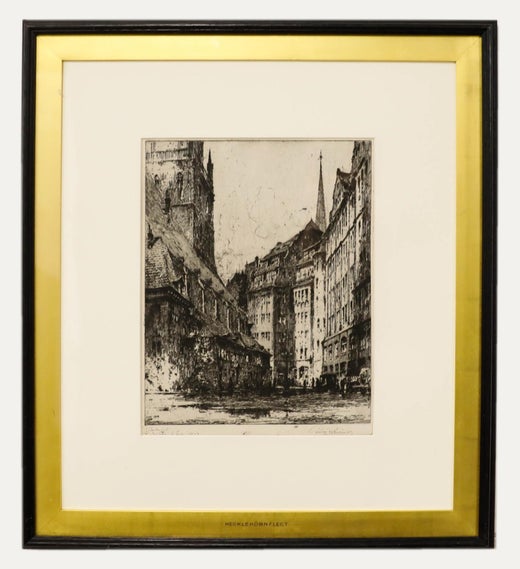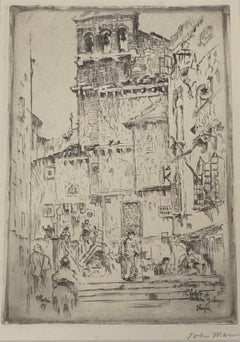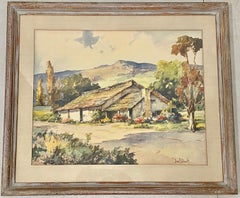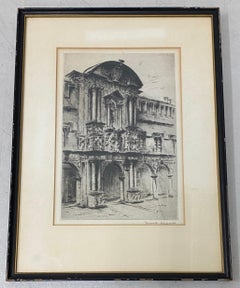Want more images or videos?
Request additional images or videos from the seller
1 of 14
Luigi KasimirLuigi Kasimir Estate Signed "SF Bay From Coit Tower" Etching c.1930s/1960s1930s/1960s
1930s/1960s
Price:$475
$750List Price
About the Item
- Creator:Luigi Kasimir (1881 - 1962, Austro-Hungarian)
- Creation Year:1930s/1960s
- Dimensions:Height: 18 in (45.72 cm)Width: 21 in (53.34 cm)Depth: 1 in (2.54 cm)
- Medium:
- Movement & Style:
- Period:
- Condition:Good condition / lightly distressed frame.
- Gallery Location:San Francisco, CA
- Reference Number:1stDibs: LU137827300472
Luigi Kasimir
Alois Heinrich “Luigi” Kasimir (Austrian, 1881-1962) was born on April 18, 1881 in Ptuj, Austria (today Slovenia) then a part of the Austro-Hungarian monarchy. He may have inherited his talent from his ancestors; his grandfather was a painter and a poet, and his father, an officer in the Habsburg army, who later became a professional painter. Kasimir attended the Vienna Academy of Art where he studied under Willhelm Unger, who introduced him to the technique of the color etching, and also to his future wife, the artist Tanna Hoernes. Kasimir was among the early practitioners of the multi-plate color etching. Before this, prints were usually hand-colored with the color being applied in a casual, haphazard manner. Kasimir would first create a sketch—usually in pastel. He then transferred the design on as many as four to six plates, printing one after the other and applying the color to the plate - all done by hand. Although Luigi Kasimir is mainly famous for his etchings, but he also produced some oil painting, as well as some pastels. One of his favorite genres was the landscape. He demonstrated a predisposition for monuments, street scenes, and tourist landmarks. He depicted places from all over Europe, mainly Italy, Austria, and Germany. He also travelled to the United States to do a series of etchings of famous sights ranging from urban landmarks such as New York skyscrapers to natural wonders like California’s Yosemite Valley. Kasimir designed a bookplate for Sigmund Freud, who also hung an etching of the Roman Forum by Kasimir in his consulting room. Kasimir’s wife, Tanna and their son Robert worked in a similar style. Luigi Kasimir died in 1962 in Grinzing, a suburb of Vienna, Austria
About the Seller
4.9
Gold Seller
Premium sellers maintaining a 4.3+ rating and 24-hour response times
1stDibs seller since 2020
553 sales on 1stDibs
Typical response time: 5 hours
Authenticity Guarantee
In the unlikely event there’s an issue with an item’s authenticity, contact us within 1 year for a full refund. DetailsMoney-Back Guarantee
If your item is not as described, is damaged in transit, or does not arrive, contact us within 7 days for a full refund. Details24-Hour Cancellation
You have a 24-hour grace period in which to reconsider your purchase, with no questions asked.Vetted Professional Sellers
Our world-class sellers must adhere to strict standards for service and quality, maintaining the integrity of our listings.Price-Match Guarantee
If you find that a seller listed the same item for a lower price elsewhere, we’ll match it.Trusted Global Delivery
Our best-in-class carrier network provides specialized shipping options worldwide, including custom delivery.You May Also Like
Mountain Village, Impressionist Aquatint Etching by Hank Laventhol
Located in Long Island City, NY
Hank Laventhol, American (1927 - 2001) - Mountain Village, Year: circa 1980, Medium: Aquatint Etching, signed and numbered in pencil, Edition: 300, AP XXXV, Image Size: 16.5 x 24...
Category
1980s Impressionist Landscape Prints
Materials
Aquatint, Etching
$385 Sale Price
30% Off
H 22 in W 30 in
Trees on the Shore of Grunewaldsee, from: Berlin Impressions - German Berlin
By Lesser Ury
Located in London, GB
This original etching and drypoint is hand signed in pencil by the artist "L. Ury" at the lower left margin.
It is numbered 20 from the standard edition of 100. There was also an edi...
Category
1920s Impressionist Landscape Prints
Materials
Drypoint, Etching
$2,100
H 14.02 in W 10.52 in
"In the Forest" Aquatint - Mid Century Engraving Landscape
Located in Soquel, CA
Charming vintage Aquatint/etching titled "In the Forest" from the Paris Etching Society by French artist Pierre Maulin (France, late 19th-early 20th Cent...
Category
1930s Impressionist Landscape Prints
Materials
Paper, Ink, Engraving, Aquatint
$199 Sale Price
20% Off
H 13 in W 15 in D 0.75 in
Early 20th Century British Street Scene - 1920s Figurative Landscape Etching
By E. Mary Shelley
Located in Soquel, CA
Highly detailed figurative landscape lithograph of a street in London with a towering cathedral, old buildings, and figures walking the street below by E. Mary Shelley (English, late...
Category
1920s Impressionist Landscape Prints
Materials
Paper, Etching
$440 Sale Price
20% Off
H 15 in W 11 in D 0.13 in
The Olives, Santa Monica Canyon - Gift by the Artist to Mary Pickford
By Arthur Millier
Located in Soquel, CA
Beautiful, simple rural scene from the early 1920s by listed British-American artist Arthur Millier (1893-1975). Signed by the artist, right corner below the image; titled lower center edge of paper below the mat "The Olives, Santa Monica Canyon" . Presented to Mary Pickford...
Category
1920s American Impressionist Landscape Prints
Materials
Paper, Printer's Ink, Etching
$879 Sale Price
20% Off
H 11.25 in W 13.13 in D 0.25 in
A Signed Etching of a Pastoral Scene in Picardy, France by Paul Emile Lecomte
By Paul Emile Lecomte
Located in Alamo, CA
A beautiful aquatint etching of a serene pastoral scene in the Picardy region of northern France by Paul Emile Lecomte (1877-1950). A mother and child are seen walking down a path in...
Category
Early 20th Century Impressionist Landscape Prints
Materials
Aquatint
$975
H 23.38 in W 27.25 in D 1.25 in
Crab Boats, Southampton Water /// Impressionist British Seascape Ship Maritime
By Aileen Mary Elliot
Located in Saint Augustine, FL
Artist: Aileen Mary Elliot (English, 1896-1966)
Title: "Crab Boats, Southampton Water"
*Signed by Elliot in pencil lower right
Circa: 1925
Medium: Original Drypoint Etching on laid p...
Category
1920s Impressionist Landscape Prints
Materials
Drypoint, Etching, Laid Paper, Intaglio
$500 Sale Price
47% Off
H 10.5 in W 15 in
Lido (Venice)
By Otto Henry Bacher
Located in Fairlawn, OH
Lido (Venice)
Etching on chine collee, 1880
Part of the artist's "Venice Set"
Signed upper right in plate :Otto H Bacher" (see photo)
Signed with the estate stamp, Lugt 2002 recto lower right beneath image. (see photo)
Created October 20, 1880
Reference: Andrew Venice No. 29
Provenance: Estate of the Artist
Otto H. Bacher (1856-1909)
Otto Henry Bacher was born in Cleveland, Ohio, to a family of German descent. He first studied art at the age of sixteen with local genre trompe l'oeil still-life artist, DeScott Evans. Although he studied with Evans for less than one year, Bacher's early work, comprised mainly of still lifes, betrays Evans's influence. After a short period in Philadelphia, where he studied at the Pennsylvania Academy of the Fine Arts, Bacher returned to Cleveland and met Willis Seaver Adams, an artist from Springfield, Massachusetts, who had just recently arrived upon the Cleveland art scene. Soon the two artists were rooming together. Adams was instrumental in the founding of the Cleveland Art Club, as well as the establishment of the Cleveland Academy of the Fine Arts, to the board of which Adams had Bacher appointed. Also during this time, Bacher began to learn the process of etching from local etcher and landscape painter Sion Longley Wenban.
In 1878, Bacher and Adams left for Europe. After stopping briefly in Scotland, Bacher went on to Munich, where he enrolled at the Royal Academy. He quickly tired of the rigors of the academy, and soon he was studying with Cincinnati artist Frank Duveneck, the prime American exponent of the Munich School. In 1879, Bacher made a trip to Florence with Duveneck as one of the celebrated "Duveneck Boys." Early the following year, the group proceeded to Venice, where Bacher and several other artists established studios in the Casa Jankovitz.
By this time an avid printmaker, Bacher had his etching press sent from Muni ch, and it was in his Venice studio that he taught Duveneck the rudiments of etching. Soon Bacher, Duveneck, and other members of the Duveneck circle were experimenting in printmaking. Among the group's contributions were some of the first American examples of monotypes, which they called "Bachertypes" because they were printed using Bacher's press.
It was also in Venice that Bacher met the venerable American expatriate artist, James McNeill Whistler. On learning of Bacher's press and his collection of etchings by Rembrandt, Whistler made himself a regular visitor to Bacher's studio, and he eventually took his own room in the Casa Jankovitz. Bacher spent much of the rest of 1880 with Whistler, the two artists sharing etching techniques. From Whistler, Bacher learned tone and line graduation; from Bacher, Whistler learned his etching techniques, including better ways of using the acid bath which produced less tedious and more efficient work. Bacher visited Whistler occasionally in the years that followed, and in 1908 he published With Whistler in Venice, his famous recollections of his time with the great artist.
Bacher spent the next two years traveling extensively throughout Italy, with Venice as the center of his operations, and he produced a number of important etchings of Italian subjects. Bacher sent several of these works to America in 1881 to be included in the Society of American artists exhibition that year, and had a similar group of works shown at the Royal Society of Painter-Etchers' first exhibition at the Hanover Gallery in London. Following the exhibition, Bacher, along with several other of the American contributors, was elected a Fellow of the Society. Bacher collected twelve of his etchings of Venetian subjects and sold them in bound volumes through his New York dealer, Frederick Keppel.
Bacher returned to Cleveland in January 1883 as a fully cosmopolitan artist. He set up a lavish studio furnished with exotic items and objets-d'art he had collected on his travels, and began to hold art classes as a means to supplement his income. He soon joined with Joseph De Camp in forming a summer sketch class in Richfield, Ohio. Bacher and De Camp also planned the Cleveland Room for a major loan exhibition in Detroit that year. During this period, Bacher increasingly painted in oil, and he began to produce sun-dappled canvases in an impressionistic mode.
Unable to sell any paintings from this early period, however, Bacher left Cleveland for Paris in 1885, where he planned to undertake further studies. Stopping first in London to visit Whistler, Bacher stayed only briefly in Paris before heading to Venice, where he spent the remainder of the year. In January 1886, Bacher returned to Paris and enrolled at the Académie Julian, and also entered the atelier of Emile-Auguste Carolus-Duran. The life of the student seems never to have suited Bacher, as he stayed in Paris only through June, before departing again for Venice. For the next six months he, Robert Blum, and Charles Ulrich...
Category
1880s American Impressionist Prints and Multiples
Materials
Etching
Brittany Landscape with Figure
By Louis Oscar Griffith
Located in Fairlawn, OH
Brittany Landscape with Figure
Etching & color aquatint, c. 1920
Signed lower right (see photo)
Numbered lower left: "No. 21" (see photo)
An early color etching by the artist, based ...
Category
1920s American Impressionist Landscape Prints
Materials
Aquatint
Barges, Dordrecht
By James Abbott McNeill Whistler
Located in Fairlawn, OH
Barges, Dordrecht
Etching, c. 1886
Signed in the plate with the butterfly
Edition: One of 10 known impressions of this image. VERY RARE
Provenance:
Frederick Keppel & Co. with their ...
Category
19th Century Impressionist Landscape Prints
Materials
Etching
More From This Seller
View AllJohn Marin "Clock Tower of Santa Maria Zobenigo, Venice, Italy" Etching c.1907
By John Marin
Located in San Francisco, CA
John Marin "Clock Tower of Santa Maria Zobenigo, Venice, Italy" Original Pencil Signed Etching c.1907
Rare pencil signed etching by listed American artist John Marin (1870-1953)
Pl...
Category
Early 20th Century Impressionist Landscape Prints
Materials
Etching
Davis F. Schwartz "Historic First Theater, Monterey County" PRINT c.1950
Located in San Francisco, CA
Davis Francis Schwartz "Historic First Theater, Monterey County" Original PRINT C.1950
PRINT dimensions 20" wide x 16" high
The distressed per...
Category
Mid-20th Century Impressionist Landscape Prints
Materials
Watercolor
Adolph Dehn "Golden Gate" Lithograph c.1940
Located in San Francisco, CA
Adolph Dehn "Golden Gate" Lithograph c.1940
Fine pencil signed lithograph issued by Associated American Artists, New York
Edition size 200.
Dimensions 1...
Category
Mid-20th Century Impressionist Landscape Prints
Materials
Lithograph
Early 20th Century European Architecture Drypoint Etching c.1930
Located in San Francisco, CA
Early 20th Century European Architecture Drypoint Etching c.1930
This fine etching is pencil signed in the lower right corner (illegible - see i...
Category
Early 20th Century Impressionist Landscape Prints
Materials
Drypoint
Harry Shoulberg "The Bridge" Serigraph c.1944
By Harry Shoulberg
Located in San Francisco, CA
Harry Shoulberg (1903-1995)
Expressionist mid modern serigraph "The Bridge" c.1944
Pencil signed and titled by the artist.
This fine serigraph retains all of it's vibrant color after 76 years!
Dimensions 12" x 15". Frame dimensions 23" x 19". Very good condition.
Please note: The linen rabbet lining of the frame does show some discoloration.
This is a rare and exceptional work by Shoulberg. His serigraphs can be found in the permanent collections of some of the finest museums, and institutions in the country.
Harry Shoulberg was born in Philadelphia, 25 October 1903 of Russian/Jewish heritage. His father, Max Shoulberg, was the fourth of twenty children and the first to be born in America. His mother was Tessie Derfler, a New Yorker of German descent. Harry grew-up in New York, married Sylvia Hendler in 1931, and had one child, Ted.
Shoulberg attended City College of New York where he studied biochemical engineering for three years before switching to fine arts in his last year. He continued his art education at the John Reed School, 1934-1935, the American Artist School, 1935-1937, and then privately at the studios of artists Sol Wilson (1894-1974) and Carl Holty (1900-1973). In 1938, he worked for the WPA and produced two oil paintings for the organization.
He maintained studios in New York City and Bridgehampton on Long Island until 1983. He was a late bloomer...
Category
Early 20th Century Impressionist Landscape Prints
Materials
Screen
“Red Square” Serigraph on Paper
By LeRoy Neiman
Located in San Francisco, CA
It almost makes one want to board Aeroflot to see this firsthand…maybe going out of Istanbul? Well no. And yet, there’s a universal energy on full display in this view by a master im...
Category
2010s American Impressionist Landscape Prints
Materials
Paper




